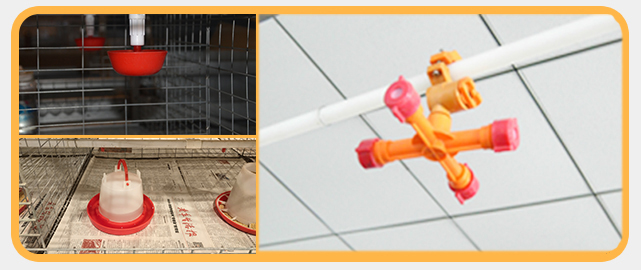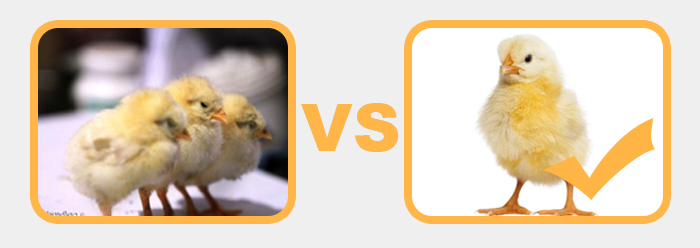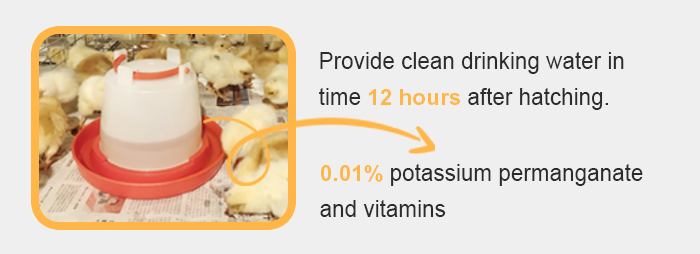Ścisła dezynfekcja
Przygotuj pomieszczenie lęgowe przed przyjściem piskląt. Dokładnie opłucz poidło czystą wodą, następnie wyszoruj gorącą wodą alkaliczną, opłucz czystą wodą i osusz. Opłucz pomieszczenie lęgowe czystą wodą, po wysuszeniu rozłóż ściółkę, włóż naczynia do lęgów, przeprowadź fumigację i dezynfekcję, stosując 28 ml formaliny, 14 g nadmanganianu potasu i 14 ml wody na metr sześcienny. Szczelnie zamknij. Po 12 do 24 godzinach otwórz drzwi i okna, aby przewietrzyć pomieszczenie i podgrzej temperaturę pomieszczenia do powyżej 30°C, aby umożliwić umieszczenie piskląt w pomieszczeniu lęgowym.

Wybierz zdrowe pisklęta
Zdrowe kurczaki są zazwyczaj żywe i aktywne, mają silne nogi, swobodny ruch, czyste oczy i dobrze zrośnięty pępek. Chore pisklę miało brudne pióra, brakowało mu energii, zamykało oczy i zasypiało, a także chwiało się w miejscu. Kupując pisklęta, upewnij się, że wybierasz zdrowe pisklęta.

Woda pitna na czas
Pisklęta mogą stracić 8% wody w ciągu 24 godzin i 15% w ciągu 48 godzin. Gdy utrata wody przekroczy 15%, wkrótce pojawią się objawy odwodnienia. Dlatego pisklętom należy zapewnić odpowiednią ilość czystej wody pitnej 12 godzin po opuszczeniu skorupy. W pierwszych dniach należy podawać im 0,01% nadmanganianu potasu i wodę z dodatkiem multiwitamin, aby zdezynfekować wodę pitną, oczyścić żołądek i jelita oraz wspomóc wydalanie smółki.

Dobrze odżywiony
Pasza powinna charakteryzować się dobrą smakowitością, lekkostrawnością, świeżością i umiarkowaną wielkością cząstek. Pisklęta można karmić w ciągu 12 do 24 godzin po wykluciu z muszli. Można je ugotować z łamaną kukurydzą, prosem, łamanym ryżem, łamaną pszenicą itp. i gotować do osiągnięcia dojrzałości 8-dniowej, co korzystnie wpływa na trawienie piskląt. Karmić 6-8 razy dziennie i w nocy przez 1-3 dni, 4-5 razy dziennie po 4 dniach i raz na noc. Stopniowo zmieniać karmę dla piskląt.

Dostosuj temperaturę i wilgotność
Tabela porównawcza temperatury i wilgotności:
| Faza karmienia (wiek dzienny) | Temperatura (℃) | Wilgotność względna (%) |
| 1-3 | 35-37 | 50-65 |
| 4-7 | 33-35 | 50-65 |
| 8-14 | 31-33 | 50-65 |
| 15-21 | 29-31 | 50-55 |
| 22-28 | 27-29 | 40-55 |
| 29-35 | 25-27 | 40-55 |
| 36-42 | 23-25 | 40-55 |
| 43-Wyeliminuj | 20-24 | 40-55 |
Jeśli w kurniku jest zbyt wilgotno, użyj wapna palonego, aby wchłonąć wilgoć; jeśli jest zbyt sucho, postaw na piecu miskę z wodą, aby zwiększyć wilgotność w pomieszczeniu.

Rozsądna gęstość
Wielkość zagęszczenia należy dostosować w sposób rozsądny do wieku piskląt, metody hodowli danej rasy oraz konstrukcji kurnika.
| Gęstość karmienia dla inkubacji 0-6 tygodni | ||
| Tygodnie wieku | Klatka szybowa | Płaskie podniesienie |
| 0-2 | 60-75 | 25-30 |
| 3-4 | 40-50 | 25-30 |
| 5-6 | 27-38 | 12-20 |
Jednostka: ptaki/㎡
Oświetlenie naukowe
Przez pierwsze 3 dni okresu lęgowego stosuj 24 godziny światła, a następnie skracaj je o 3 godziny tygodniowo, aż do momentu, gdy okres lęgowy zostanie ustalony. Intensywność światła wynosi: żarówki o mocy 40 watów (rozstawione w odległości 3 metrów, na wysokości 2 metrów od podłoża) przez pierwszy tydzień. Po drugim tygodniu użyj żarówki o mocy 25 watów, o natężeniu światła 3 watów na metr kwadratowy i równomiernym oświetleniu. Moc pojedynczej żarówki nie powinna przekraczać 60 watów, aby uniknąć dziobania.

Zapobieganie epidemii
Niehigieniczne i wilgotne środowisko sprzyja chorobom kur, zwłaszcza pullorum i kokcydiozie. Kurnik powinien być regularnie i dokładnie dezynfekowany, utrzymywany w suchości i czystości, ściółka powinna być często zmieniana, woda pitna powinna być czysta, a karma świeża.
| Wiek | Sugerować |
| 0 | Wstrzyknąć 0,2 ml liofilizowanej szczepionki przeciwko wirusowi opryszczki indyków, wywołującemu chorobę Mareka. Dodać 5% glukozy, 0,1% witamin, penicylinę i streptomycynę do wody pitnej. |
| 2~7 | Dodać 0,02% furteryny do wody pitnej i wymieszać z paszą 0,1% chloramfenikolu. |
| 5~7 | Szczepionki przeciwko chorobie Newcastle II lub IV podaje się do oczu i nosa w przepisanej dawce. |
| 14 | Szczepionka Mareka podskórnie |
| 18 | Wstrzyknięcie szczepionki przeciwko zapaleniu kaletki maziowej |
| 30 | Szczepionka przeciwko chorobie Newcastle II lub IV |
Uwaga: Chore kurczaki należy na czas odizolować, a martwe kurczaki należy trzymać z dala od kurnika i głęboko zakopać.
Świeże powietrze
Wzmocnij wentylację w pomieszczeniu, w którym kurnik się kurzy, i utrzymuj świeże powietrze w kurniku. Wietrzenie kurnika można przeprowadzić w południe, gdy słońce świeci najmocniej, a stopień otwarcia drzwi i okien waha się od małego do dużego, a w końcu do półotwartego.

Skrupulatne zarządzanie
Konieczna jest częsta obserwacja stada i zrozumienie jego dynamiki. Należy ograniczyć czynniki stresogenne i zapobiegać przedostawaniu się kotów i myszy do kurnika.

Czas publikacji: 10 grudnia 2021 r.







